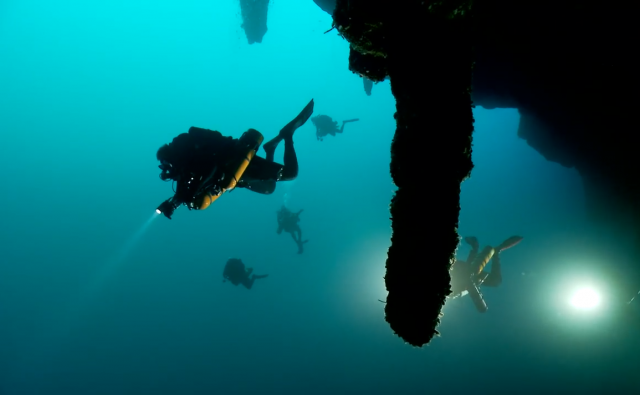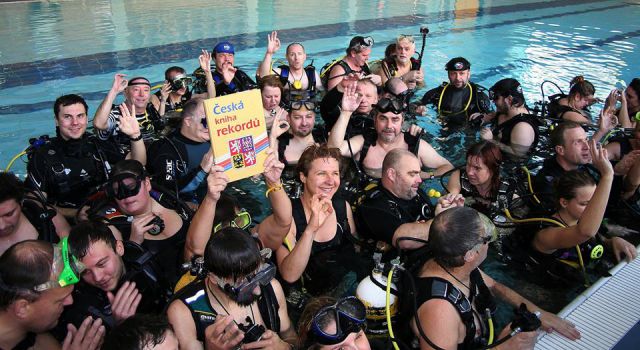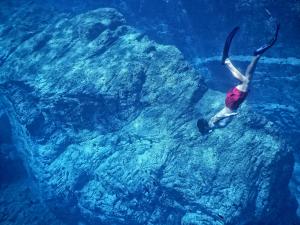Frequently Asked Questions about Cave Diving
What makes diving in overhead environments significant?
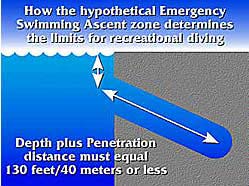
The Single Greatest safety factor in open-water diving is that, no matter what happens (equipment malfunction, loss of breathing gas supply, loss of buddy, etc.), open-water divers always have the option of making independent, controlled emergency-swimming ascents (ESAs). Two factors make this possible:
- Open-water divers who remain within the recommended depth limits for recreational diving are usually less than 100 feet from the surface and never more than 130 feet from air. Making emergency swimming ascents would be significantly more difficult if recreational divers ventured further than this.
- With the exception of certain recreational-level specialty diving activities (cavern, wreck and ice diving), open-water divers are never under overhead obstructions that would prevent them from making an immediate and direct ascent to the surface.
Obviously, any time divers place a barrier between themselves and the surface, they compromise their ability to make controlled emergency swimming ascents. Thus, by entering overhead environments, they deprive themselves of recreational diving’s greatest safety factor.
How do cavern and cave diving differ from one another?
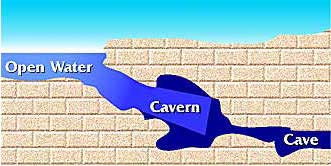
Cavern diving is the exploration of permanent, naturally occurring overhead environments while remaining within sight of their entrances. It differs from cave diving in that, while cave divers may penetrate thousands of yards, cavern divers generally go no further than 130 feet from the surface. Additionally, cavern divers keep the entrance clearly in sight at all times, and use a guideline so that, should sight of the entrance be accidentally lost, divers can immediately regain it.
By taking these steps, cavern divers remain able to make emergency swimming ascents and, thus, restore the safety margin they enjoy in open water. Properly trained and equipped wreck and ice divers who wish to remain within recreational diving limits take similar steps to ensure they maintain a comparable safety margin when entering their unique overhead environments. Because cavern divers remain within the controlled emergency-swimming ascent zone, while cave divers go far beyond it, there are several other significant differences between cavern and cave diving.
- Cavern diving is, by definition, a form of recreational diving. This means, among other things, that divers can obtain recreational-level Specialty Diver certifications in cavern diving from open-water training agencies such as NAUI, PADI, SDI and SSI.
- In contrast, experts consider cave diving a form of technical diving. As such, the various levels of Cave Diver certification are available only through cave diving organizations, such as the National Speleological Society Cave Diving Section (NSS-CDS) and the National Association for Cave Diving (NACD), and technical diving organizations, such as GUE, IANTD, NAUI Tech and TDI.
- Because the risks that cavern divers must manage are not significantly greater than they experience in open water, cavern divers are able to use much the same equipment as they use in open water. Being in underwater caverns requires that divers make a few modifications to their equipment; however, most divers say that these modifications make their open-water diving easier and more enjoyable. Cave divers, on the other hand, use highly specialized equipment to reduce the risks they encounter to an acceptable level.

One such example is gas-delivery systems. cavern divers use single tanks with K-valves and a single regulator first stage. Cave divers — whether using double or single tanks — use systems in which a single gas supply feeds two separate on/off valves and regulator first stages. Should a valve-to-regulator O-ring rupture or a regulator begin free flowing, cave divers can shut off the offending regulator/valve combination and exit using the remaining regulator and valve.
Because cavern diving is still a form of recreational scuba, with modest risk factors, it is an activity that a number of experienced recreational divers can learn and enjoy. Cave diving, in contrast, is for a far more select group of individuals. Cave divers should possess near-instructor-quality buoyancy control and general diving skills. They should be utterly committed to diving in a highly disciplined and methodical manner and have an above-average understanding of the technical aspects of diving.
How does cave diving differ from other types of overhead environment?
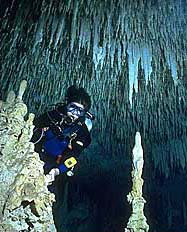
Cave diving differs from other forms of overhead environment diving in several significant respects. Among them:
- Caves are especially fragile environments. While wreck and ice divers must also take care not to cause damage to their unique environments, the degree of care they must exercise is vastly eclipsed by that cave divers must exercise to protect irreplaceable cave formations from harm.
- Cave diving generally involves penetration distances vastly greater than those experienced by wreck and ice divers. This requires the utmost in self sufficiency and self reliance.
- Wreck diving generally takes place in significantly colder water than cave diving. Ice diving takes place in substantially colder water. This can have a profound impact on equipment configuration and technique.
The bottom line is that, despite the fact cave, wreck and ice diving all take place in overhead environments, they are separate and distinct activities. Each involves a different set of risks, and each requires its own unique equipment, techniques and procedures.
As a consequence, there can be no such thing as generic "overhead environment diver" training or equipment. No amount of training or experience in ice or wreck diving can adequately prepare divers to or cave dive (and vice versa). Similarly, equipment that represents an acceptable configuration for ice or wreck diving is not automatically an acceptable configuration for cave diving.
Why Cave Dive?
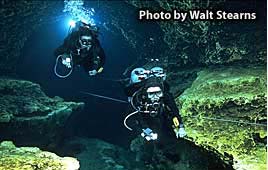
Most cave divers agree that the reasons they enjoy exploring natural overhead environments are difficult to verbalize. These reasons do, however, include:
- Underwater caves are extremely beautiful. They offer clear water and unique geological formations that divers cannot see or enjoy elsewhere.
- Caves offer diving that is free from wind, waves and surge. Seasickness is never a consideration when diving inland caverns and caves. Additionally, visibility in many freshwater caves measures hundreds of feet — clearer than any ocean water you are likely to find at even the best dive resorts.
- Cave diving are among the most exciting of all diving activities. There are no dull cave dives.
- Cave diving provide a unique insight on how the earth formed and on how life on earth evolved.
- Cave divers seem to share both a powerful curiosity and an appreciation of the technical aspects of overhead-environment diving.
Among the most satisfying aspects cave diving is the understanding that this is not a suitable activity for the average diver. In fact, some estimate that less than one percent of the general diving population possess the knowledge, skills, experience, attitude and judgement necessary to learn to cave dive as safely as possible. Thus, the ability to meet the high standards required for Cave Diver certification is something of which any person can be justifiably proud.
Why Is Special Training Needed for Cave Diving?
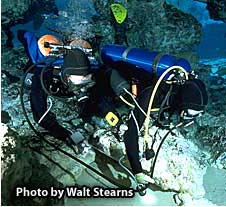
Safe cave diving is not quite as simple as merely trying to keep the entrance in sight at all times or learning to use special equipment. There are many other aspects of these activities that one can learn only in cave diving courses. These include:
- Guideline and Reel Use: Learning to use a reel and guideline is not a do-it-yourself proposition; it requires as much instruction and practice as learning to master buoyancy control — if not more so. We devote a significant portion of Cave Diver training to proper use of a guideline and reel, and give each student plenty of opportunity to practice.
- Specialized Buoyancy Control, Body Position and Propulsion Techniques: Without these specialized skills, the average open-water diver quickly turns the most pristine cave environment into a silty, disgusting mess. This not only impairs the enjoyment of cave diving, it is downright dangerous. Thus, special buoyancy-control, body positioning and propulsion techniques are an integral part of Cave Diver training.
- Equipment Modification: Normal open-water diving equipment is actually hazardous in environments. Cave diving requires highly specialized equipment that is vastly different from what divers use in open water. Cave Diver training focuses on identifying, acquiring and fine-tuning the specialized equipment that divers need for this unique activity.
- Dive Planning: Planning a cave dive is nothing at all like planning an open-water dive. In open water, a dive planning may consist solely of waiting to reach a cylinder pressure of 500 to 1,000 psi, then surfacing. In contrast, the cave diver who waits until his or her pressure-gauge needle hits the "red" zone, before starting to exit, will likely never see daylight again.
Cave Diver training places heavy emphasis on the highly specialized dive planning procedures required for safer penetrations of overhead environments. This involves not only breathing-gas management, but attention to factors such as sequence, depth, duration, distance and direction.
At one time, recreational divers could use most of north-central Florida’s freshwater springs without someone scrutinizing their training and experience. Today, state park authorities and private owners restrict access to most of these sites to certified Cave Divers.
What are the additional benefits of Cave Diver training?
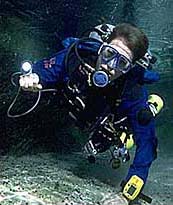
The benefits of Cave Diver training are not limited solely to the ability to safely explore underwater caverns and caves.
- Most students say that they learn more practical information about diving in just the first few days of Cave Diver training than in any other course they have taken — including instructor courses!
- The equipment modifications one learns as a Cave Diver are not only essential for diving in overhead environments, they make open-water diving much easier as well.
- The specialized buoyancy control, body position and propulsion techniques taught in Cave Diver courses create very environmentally sound divers. One seldom sees cave divers banging into or dragging equipment across coral reefs.
- Many cave diving students are wreck divers who are seeking to learn penetration procedures and techniques they can apply to wreck diving. Although cave diving are distinctly different activities from wreck diving, many wreck divers report they find learning to cave dive helpful.
More than anything else, certified Cave Divers say that these courses are simply some of the most enjoyable experiences one can have while diving. And, when asked to describe what they got from any one course, the first words are invariably, “We learned so much!”
By Johnny Richards
Source: cavediving.com






